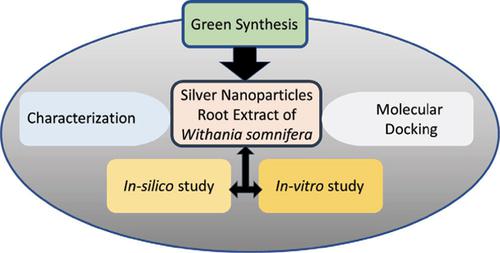Current Pharmaceutical Biotechnology ( IF 2.8 ) Pub Date : 2020-11-30 , DOI: 10.2174/1389201021666200702152000 Isha Gaurav 1 , Tanuja Singh 2 , Abhimanyu Thakur 3 , Gaurav Kumar 4 , Parth Rathee 5 , Puja Kumari 3 , Kumari Sweta 3

|
Background: Metal Nanoparticles (NPs) have been widely used for various applications in biomedical sciences, including in drug delivery, and as therapeutic agents, but limited owing to their toxicity towards the healthy tissue. This warrants an alternative method, which can achieve the desired activity with much reduced or no toxicity. Being a biological product, Withania somnifera (W. somnifera) is environment friendly, besides being less toxic as compared to metal-based NPs. However, the exact mechanism of action of W. somnifera for its antibacterial activities has not been studied so far.
Objective: To develop “silver nanoparticles with root extract of W. somnifera (AgNPs-REWS)” for antimicrobial and anticancer activities. Furthermore, the analysis of their mechanism of action will be studied.
Methods: Using the in-silico approach, the molecular docking study was performed to evaluate the possible antibacterial mechanism of W. somnifera phytochemicals such as Anaferine, Somniferine, Stigmasterol, Withaferin A, Withanolide- A, G, M, and Withanone by the inhibition of Penicillin- Binding Protein 4 (PBP4). Next, we utilized a bottom-up approach for the green synthesis of AgNPs- REWS, performed an in-detail phytochemical analysis, confirmed the AgNPs-REWS by SEM, UVvisible spectroscopy, XRD, FT-IR, and HPLC. Eventually, we examined their antibacterial activity.
Results: The result of molecular docking suggests that WS phytochemicals (Somniferine, Withaferin A, Withanolide A, Withanolide G, Withanolide M, and Withanone) possess the higher binding affinity toward the active site of PBP4 as compared to the Ampicillin (-6.39 kcal/mol) reference molecule. These phytochemicals predicted as potent inhibitors of PBP4. Next, as a proof-of-concept, AgNPs- REWS showed significant antibacterial effect as compared to crude, and control; against Xanthomonas and Ralstonia species.
Conclusion: The in-silico and molecular docking analysis showed that active constituents of W. somnifera such as Somniferine, Withaferin A, Withanolide A, Withanolide G, Withanolide M, and Withanone possess inhibition potential for PBP4 and are responsible for the anti-bacterial property of W. somnifera extract. This study also establishes that AgNPs via the green synthesis with REWS showed enhanced antibacterial activity towards pathogenic bacteria.
中文翻译:

通过与青霉素结合蛋白-4的结合,用Withania somnifera根提取物对银纳米粒子的合成,体外和计算机模拟评估抗菌活性。
背景:金属纳米颗粒(NPs)已广泛用于生物医学科学中的各种应用,包括药物递送和治疗药物,但由于其对健康组织的毒性而受到限制。这保证了另一种方法,该方法可以实现所需的活性,并且毒性大大降低或没有毒性。作为一种生物产品,Withania somnifera(W. somnifera)除与金属基NP相比毒性较小之外,还对环境友好。但是,迄今为止尚未研究过W. somnifera对其抗菌活性的确切作用机理。
目的:开发“具有W. somnifera根提取物的银纳米颗粒(AgNPs-REWS)”以具有抗微生物和抗癌活性。此外,将研究其作用机理的分析。
方法:采用计算机模拟方法,进行了分子对接研究,以评估W. somnifera植物化学物质(如Anaferine,Somniferine,Stigmasterol,Withaferin A,Withanolide- A,G,M和Withanone)的抗菌机制。青霉素结合蛋白4(PBP4)的制备。接下来,我们采用了自下而上的方法对AgNPs-REWS进行绿色合成,进行了详细的植物化学分析,并通过SEM,紫外可见光谱,XRD,FT-IR和HPLC确认了AgNPs-REWS。最终,我们检查了它们的抗菌活性。
结果:分子对接的结果表明,与氨苄西林相比,WS植物化学物质(Somniferine,Withaferin A,Withanolide A,Withanolide G,Withanolide M和Withanone)对PBP4活性位点的结合亲和力更高(-6.39 kcal / mol)参考分子。这些植物化学物质预测为PBP4的有效抑制剂。接下来,作为概念验证,AgNPs-REWS与粗品和对照品相比均显示出显着的抗菌作用。对抗黄单胞菌和罗尔斯顿菌种。
结论:计算机内和分子对接分析表明,W。somnifera的活性成分如Somniferine,Withaferin A,Withanolide A,Withanolide G,Withanolide M和Withanone具有抑制PBP4的潜力,并具有抗菌作用。 W. somnifera提取物。这项研究还确定,通过REWS的绿色合成,AgNPs对病原菌表现出增强的抗菌活性。


























 京公网安备 11010802027423号
京公网安备 11010802027423号